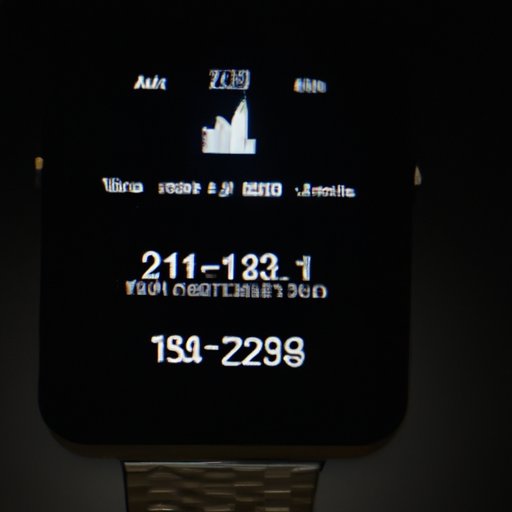An Overview of Apple Watch’s Calorie Calculation System
The Apple Watch is a smartwatch developed by Apple Inc. It has many features, including fitness tracking and calorie counting. While it may seem like a complex task, understanding how the Apple Watch calculates calories burned can help you get the most out of your device and use it to reach your fitness goals.
Exploring the Science Behind Apple Watch’s Calorie Counting Ability
At its core, the Apple Watch uses sensors and algorithms to measure your activity and estimate the number of calories burned. The watch is equipped with an accelerometer, which tracks your movements and the intensity of your exercise. It also has a heart rate monitor that measures your pulse throughout the day.
Using these sensors, the Apple Watch can estimate the number of calories you burn during physical activities. For example, when you go for a run, the watch will track your speed and distance and use this data to calculate the amount of energy you’ve expended. The watch can also use your heart rate to estimate the number of calories burned.
In addition to the sensors, the Apple Watch also uses algorithms to analyze the data collected from your body and environment. These algorithms take into account factors such as your age, weight, height, gender, and lifestyle to more accurately estimate the number of calories burned.
Other factors, such as the temperature and humidity, can also influence the accuracy of the calorie counting feature. For instance, if it’s hotter or more humid outside, your body will need to expend more energy to cool itself, resulting in a higher calorie count.
A Step-by-Step Guide to Tracking Calories Burned with an Apple Watch
If you want to start tracking your calories burned with an Apple Watch, here’s a step-by-step guide to get you started:
1. Setting up the calorie tracking feature. First, you have to enable the calorie tracking feature on your Apple Watch. To do this, open the Activity app on your iPhone and tap “Settings”. Then, select “Calorie Goal” and set the goal that you want to reach. This will activate the calorie tracking feature on your Apple Watch.
2. Understanding your personal metrics. Once you’ve activated the feature, the Apple Watch will start tracking your calorie burn. To get the most accurate results, you should enter your age, weight, height, and gender into the app. This will allow the watch to better estimate your calorie burn based on your personal metrics.
3. Analyzing data and trends over time. The Apple Watch will track your daily calorie burn and display it in the Activity app on your iPhone. You can also view this data in graphs and charts to see how your calorie burn changes over time. This can help you identify patterns and make adjustments to your diet and exercise routine.
Comparing Apple Watch’s Calorie Counting to Other Wearables
When it comes to accuracy, the Apple Watch is generally considered to be one of the most reliable devices for tracking calories burned. However, there are other wearables on the market that offer similar features and benefits. For example, some devices use built-in GPS to track your location and calculate the number of calories burned during outdoor activities.
Other wearables also offer additional features such as sleep tracking, hydration monitoring, and stress management. Depending on your needs, you may want to consider these other options and compare them to the Apple Watch before making a purchase.
The Benefits of Using an Apple Watch to Track Calories Burned
The Apple Watch can be a great tool for anyone looking to improve their overall fitness and health. By tracking your calorie burn, you can set realistic goals and track your progress over time. The watch can also provide motivation through fitness challenges, rewards, and achievements.
In addition, the Apple Watch can help you manage your health and lifestyle. With its advanced sensors and algorithms, the watch can provide insights into your sleep quality, stress levels, and other important metrics. This can give you a better understanding of your body and help you make informed decisions about your diet and exercise routine.
Investigating How Accurate Apple Watch’s Calorie Counting Is
While the Apple Watch is generally considered to be accurate, there are several factors that can affect its accuracy. For example, the watch’s calorie counting ability relies heavily on the accuracy of its sensors and algorithms. If these components are not working correctly, the watch may not be able to accurately track your calorie burn.
In addition, the accuracy of the Apple Watch’s calorie counting feature can be affected by environmental factors such as temperature and humidity. As mentioned earlier, these factors can cause your body to expend more energy and result in a higher calorie count.
Finally, the accuracy of the Apple Watch’s calorie counting may vary depending on the user. For example, individuals with higher body fat percentages may experience less accurate readings due to the increased insulation provided by their body fat.
Overall, the Apple Watch is generally considered to be a reliable device for tracking calories burned. However, it’s important to understand that the accuracy of the watch’s calorie counting feature can be affected by various factors. Therefore, it’s important to take these factors into account when evaluating the accuracy of the watch’s calorie counting.
Conclusion
The Apple Watch is an incredibly useful device for tracking calories burned. It uses sensors and algorithms to measure your activity and estimate the number of calories burned. Additionally, the watch can provide insights into your sleep quality, stress levels, and other important metrics. Finally, the accuracy of the watch’s calorie counting feature can be affected by environmental factors and individual characteristics. Overall, the Apple Watch is generally considered to be a reliable device for tracking calories burned.


